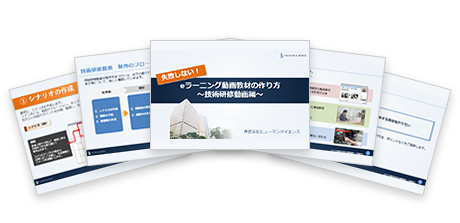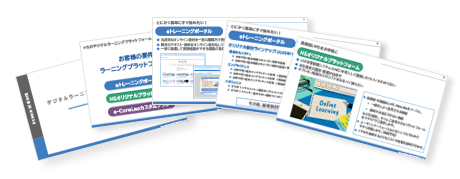2024.03.14
2025.10.31
How to create high-quality video materials that enhance the learning effectiveness of e-learning

In recent years, e-learning materials have increasingly included not only text and slides but also video formats. Videos make it easier to convey information visually and are expected to deepen learners' understanding; however, simply creating video materials alone does not guarantee sufficient learning effectiveness. Depending on the content, learners may lose concentration or find it difficult to achieve effective learning outcomes.
This time, we will explain key points for creating high-quality video teaching materials. Please use this as a reference for tips on making more effective e-learning materials.
1. Common Challenges Related to e-Learning Materials

Essential Delivery Systems and Teaching Materials for e-Learning Operations
E-learning is being adopted by many companies, but there are stories of failures where it was not utilized much or where learning effects were not observed.
There are various factors to consider, but one of them is the "quality of the materials" that can have an impact. First, let's organize some common challenges related to e-learning materials.
Superficial Content
If the content of the teaching materials is superficial and lacks specificity, learners may not be able to acquire practical knowledge and skills.
Outdated or Incorrect Content
If statistical data is outdated or errors have not been corrected, and information is not updated, there is a risk of learning incorrect information that differs from the latest facts and insights.
Learning objectives are unclear
If the teaching materials do not clearly state what is to be learned or what is to be achieved, the content may become half-hearted, causing confusion for learners and potentially leading to a loss of motivation to study.
Monotonous progression
If the content is monotonous, such as just a continuous list of text, it becomes difficult to motivate learners and maintain their willingness to continue studying.
Technical issues
If the usability of the materials is poor or there are many bugs and errors, learners will feel stressed and their motivation to learn will decrease.
These issues cause learning effectiveness to decline. To create high-quality e-learning materials, it is necessary to be careful to avoid such problems.

2. Ways to Improve the Quality of e-Learning Materials

Considering the challenges related to the aforementioned e-learning materials, what specific measures can be taken to enhance the quality of the materials? Below is a summary.
●Utilize videos and audio
By utilizing videos and audio, we enhance learners' understanding by conveying information from multiple perspectives.
●Enhance visual elements
By utilizing graphs, charts, animations, and more, we explain complex concepts in an easy-to-understand manner. This is effective when you want to help people understand content that is difficult to visualize with just text or narration.
●Incorporate unique customization elements
By adding information such as internal company rules and using case studies based on your own company or industry examples, customizing the materials to your company's unique specifications allows learners to obtain "high-resolution information" that can be applied in the field.
●Provide an interactive learning experience
By incorporating interactive elements such as quizzes, exercises, and simulations, we can enhance learners' motivation and encourage participation.
●Clearly define learning goals and objectives
By clarifying the goals and objectives of learning, learners can more easily understand what they should achieve. This is expected to enhance their awareness of learning and encourage them to focus on their studies.
●Regularly update content
We regularly review and update content to align with the latest information and trends. By maintaining the freshness of the materials, learners can acquire accurate knowledge.
By combining these efforts, the materials become even more comprehensive, leading to improved learning outcomes and increased motivation to learn.
3. Types of Video Materials
It has been found that video materials are effective in enhancing learning outcomes in e-learning.
In this chapter, we will look at the different types of video materials used in e-learning.
Types of Video Materials
・Lecture Videos
Videos where instructors and internal training personnel explain the course content. A typical lecture style is often seen, where the presenter speaks while showing slides.
・Training Videos
Videos capturing the scenes of group training. They are often used for the learning of those who were absent and for reviewing the content of the group training.
・Demonstration Video
A video that shows how to use the product and the technical procedures in action. It helps deepen understanding of movements and nuances that are difficult to explain in words by watching the practical demonstration.
・Simulation Videos
Videos that simulate specific situations or environments, such as customer service scenes and trouble handling. By recreating actual experiences and situations, it deepens learners' understanding to enable them to respond to real-life scenarios.
・Animation Videos
Videos that utilize graphics and animation to explain complex processes and concepts. They are easy to understand and help enhance learning effectiveness.
・Interview Videos
Videos that share knowledge and experience through interviews with experts and senior employees. They provide more practical advice and tips.
Providing materials as videos helps effectively convey diverse information that cannot be fully expressed through text-based teaching materials or documents alone.

4. Main Methods for Creating Video Materials

There are several methods to create video materials. Here, we will explain the five main methods.
1. Live Action Video (Camera Shooting)
This method involves using a camera to film actual lectures or demonstrations. Instructors can explain directly to the camera, or present case studies in a drama-like style, allowing for a variety of expressions that showcase originality. On the other hand, filming and editing require effort, and the more complex the content, the more labor-intensive the process becomes.
2. PowerPoint
PowerPoint allows you to easily create video materials by inserting diagrams and illustrations, adding animations, and embedding videos. Additionally, its low production cost is an attractive feature. On the other hand, the quality of the materials tends to be lower as educational content.
3. Recording Function of Online Meeting Tools
If you want to create video materials more easily, using the screen recording functions of tools like Zoom or Teams is also an option. Since you can record materials displayed via screen sharing as they are, no editing is needed afterward. However, the recording function depends on the quality of the connection, so if the connection is unstable and the video or audio quality is poor, there is a risk that the quality of the materials will decline.
4. e-Learning Material Creation Tools
By using e-learning material creation tools, you can easily create video materials. These tools offer many templates and resources, enabling more effective presentations. However, some tools may have limitations on capacity and features. Additionally, thorough security measures must be ensured.
5. Request Creation from a Professional Vendor
This is a method of ordering custom video materials from vendors (sales companies) that provide e-learning materials. Although it incurs costs, a significant advantage is that you can create original video materials for your company while leveraging professional expertise. Additionally, unlike complete in-house production, the inclusion of a "third-party perspective" helps to reduce bias in the content of the materials.
There are advantages and disadvantages to each method of creating video materials. Considering these, let's choose the best approach for our company.
5. Key Points for Creating Easy-to-Understand Video Materials

This chapter introduces five points for creating effective and easy-to-understand video materials.
〈Point 1〉Keep it concise within 5 to 10 minutes
If video materials are too long, learners may lose concentration and learning efficiency may decrease. Therefore, it is ideal to keep each video within 5 to 10 minutes. By summarizing in a short time, the burden on learners is reduced, allowing for more efficient learning.
(Examples of ways to summarize concisely)
・If there is a lot of content to convey, divide the video into smaller parts by theme
・At the beginning of the video, clearly state the "learning goals and objectives" to encourage awareness of what will be learned
〈Point.2〉Focus on One Theme per Video
Packing too much information into a single video can confuse learners. Therefore, try to limit each video to one theme. This makes the video structure simpler and easier to edit for the creators. Additionally, by organizing related videos into a series, it becomes easier to structure the learning flow, which also helps improve learners' understanding.
〈Point.3〉Explain While Showing Actual Actions
The strength of video teaching materials lies in their ability to convey information visually. By leveraging this characteristic and explaining while showing actual actions, you can enhance learning effectiveness. For example, in videos teaching software operation methods, using screen captures to demonstrate the actual operation allows you to supplement only key points and cautions, keeping the content simple.
〈Point.4〉Incorporate Story Elements
In monotonous explanatory videos, it becomes difficult to capture learners' interest and attention. By incorporating story elements, you can create more immersive educational materials. For example, in materials for learning business skills, using a story format centered on interactions between a new employee and a senior employee, showing the newcomer’s growth, makes the learning content easier to absorb naturally. Additionally, story-based videos are easier to remember and resonate with learners, which can also boost motivation.
〈Point.5〉Continuously improve based on feedback from learners
Video materials are not "completed once made"; rather, review and update the content while checking learners' reactions and understanding. By conducting surveys after the course to gather opinions, analyzing viewing data to review parts with high dropout rates, and making continuous improvements, the quality of the materials will improve. As a result, this leads to maximizing learning effectiveness and increasing learner satisfaction.
To create easy-to-understand video materials, it is important to devise the structure and production while keeping the "learner's perspective" in mind. By incorporating the points introduced this time, aim to create video materials that are easy to understand and can be applied in practice.
6. Summary

This time, we have explained how to create high-quality content with the theme of e-learning "video materials." Video materials, which combine various elements such as images, audio, subtitles, and animations, can offer high learning effectiveness; however, the time and effort required in the production process can be a drawback. Therefore, it may be worth considering entrusting some parts of the process or materials to professionals.
Human Science, one of the vendors of e-learning materials, has a track record of producing over 3,000 e-learning materials since the start of its service in 2000. Regarding video materials as well, we have supported various types of filming such as group training sessions, lectures, in-house meetings, 360-degree camera shooting, and chroma key shooting, providing services to companies across a wide range of industries.
In addition to video materials, we also provide optimal proposals tailored to our clients' needs, including planning and design of educational materials, mobile compatibility using HTML5, and content migration related to LMS replacement.
For inquiries regarding video materials and e-learning, please feel free to contact Human Science.
For more details, you can also visit the e-learning site of Human Science.
> e-Learning Video Material Production
> e-Learning Content Production













